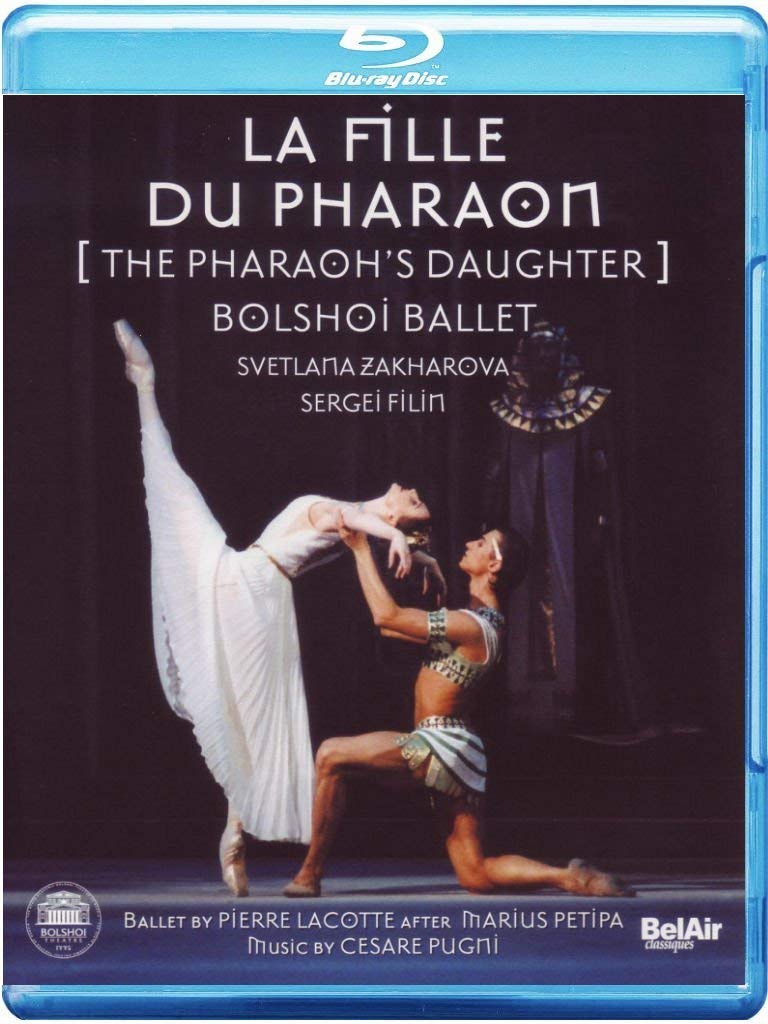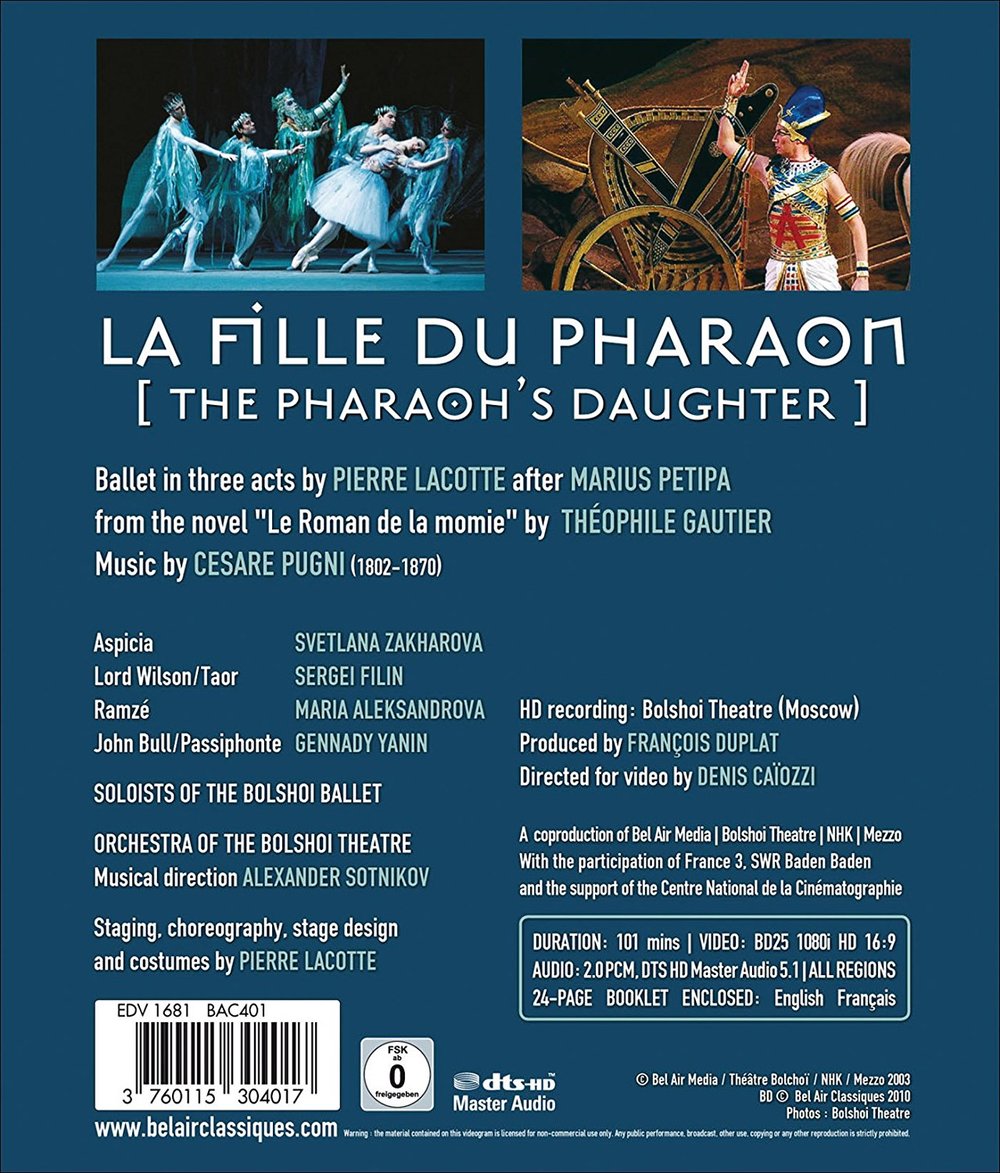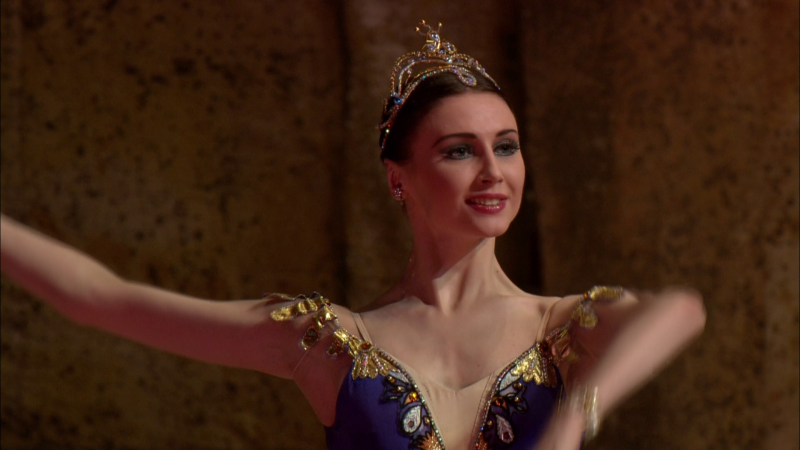

La fille du pharaon ballet. Music by Cesare Pugni. Choreographed by Pierre Lacotte after Marius Petipa. Filmed 2003 at the Bolshoi Theatre. Stars Svetlana Zakharova (Aspicia), Sergei Filin (Lord Wilson/Taor), Gennadiy Yanin (John Bull/Passiphonte), Maria Aleksandrova (Ramzé), Dimitri Gudanov (The Fisherman), Inna Petrova (The Fisherman’s Wife); Anna Tsygankova, Anastasia Goryatcheva, Denis Medvedev, Yan Godovsky (Pas d’action); Vladimir Moiseev (King of the Nile), Anastasia Yatsenko (River Guadaquivir), Ekaterina Shipulina (River Congo), and Elena Andrienko (River Neva). Alexander Sotnikov conducts the Orchestra of the Bolshoi Theatre. Staging, stage design, and costumes by Pierre Lacotte. Directed for TV by Denis Caïozzi. This disc, unlike all other fine-art HDVDs released to this point, has no traditional menu. Instead the show starts directly. There is a brief message displayed at the beginning telling the viewer that the pop-up menu allows the viewer to change the audio setting and to select scenes. (A note on scene selection: getting to Acts II and III is a bit counterintuitive. After selecting "Scenes" from the pop-up menu, a secondary menu with all of Act I's scenes appears. To get to Acts II and II, the viewer must first go back to the original pop up menu, and suddenly Acts II and III become selectable.) Released 2010, disc has 5.1 dts-HD Master Audio sound. Grade: A
BelAir is a French company. The disc package and the liner notes are in French and English. But the Chapter titles are presented only in French. Here are the Chapter titles in English:
Introduction / Sandstorm at the Foot of the Pyramids
The Dream
The Royal Hunt
The Monkey
The Night
The Royal Hunt (conclusion)
Taor's Exploit
Gathering at the Palace
The Engagement
The Grand Procession 1 (pas d'action)
The Mirror
The Grand Procession 2 (pas d'action)
The Grand Procession 3
The Contract
Escape from the Palace
The Fishermen's Village
Three Rivers
The Kingdom of the Nile
Condemnation
Aspicia's Return
Love's Triumph
Awakening
Ballet is the most esoteric, fragile, and perishable of the fine arts. A ballet is peculiar to the choreographer creating it, enormously expensive to produce, seen live by few people, almost impossible to document on paper, and hard to record in media. HDVD will benefit ballet more than the other fine arts because high-definition cameras and high-fidelity sound for the first time offer an economical way for more people to enjoy ballet and for the dance movements to be documented adequately for posterity.
Consider the fate of the ballet La fille du pharaon. In 1862, La Fille du Pharaon was the first great success of choreographer Marius Petipa (who was also the lead male dancer and who went on to become the most important choreographer in history). Petipa revived it several times before his death in 1910. The ballet was never performed outside Russia. The last Russian revival was in 1926. After that, the Communists dropped it (I guess because Lord Wilson, the lead male role, was too much of a symbol of imperialistic capitalism).
Knowledge about La fille du pharaon withered. Documents, sets, and costumes were mostly trashed or lost.
When Pierre Lacotte started working on his 2000 reconstruction, there were few people alive who had seen it. The only visual records were sketches and black and white photos. Music scores were in archives, but it seems that no sound recording of the music was ever published. Lacotte found Marina Semionava, who was the last Aspicia when she danced it at age 17. But at about age 88, she could not remember the choreography.
Svetlana Zakharova as Aspicia in 2003.
Eventually, Lacotte was able to sleuth out enough material to piece together a 1 hour and 40 minute version for the Bolshoi Ballet that probably does a decent job of portraying the main roles and at least gives a taste of the spectacular chorus action (the original ballet lasted more than 4 hours and had 400 parts). The truncated version opened in Moscow in 2000 and was recorded in 2003. The DVD was released in 2005 and the HDVD was released 2010. Petipa's almost lost work has been rescued from oblivion! (We will never see the full version; nor should we want to. To us, "spectacular" means something like the opening ceremonies at the Summer Olympics.)
So how does La fille du pharaon come across in HDVD? Cesare Pugni was the most prolific ballet composer in history, and he composed much other music as well. But he is today mostly ignored. For example, ArkivMusic offers not a single music recording devoted to Pugni. (Bits of his music can be heard on videos of ballets and compilations of ballet music.) But for someone who isn't even on the radar, Pugni's music is surprising good! For this libretto, a string of pearls is fine; there's no need for architecture or psychological depth. Pugni ceaselessly comes up with new melodies and orchestral combinations that are never boring. He's clearly on a level above, say, the compilations of Lanchbery that we know from La fille mal gardée and Tales of Beatrix Potter. I think Pugni is competitive in this music with most or all of Adams in Giselle and also on occasion approaches some of Mendelssohn and Tchaikovsky. And for sure, his music is completely adequate for and well coordinated to what's happening on the stage in La fille du pharaon.
A few reviewers have complained that the choreography is not exciting or original. Such comments may have some validity when you consider all the romantic, classical, and modern dancing what we now know. But this view is also misguided. The dancing we see in La fille du pharaon is not mature Petipa. Rather, these are images from the dawn of grand Russian ballet. But if you have seen much of Petipa's more famous works, you will find in this production green shoots of all that is to come later.
Above, three scenes from a grand celebration. The original production had 400+ roles.
The finale with adulation of the Pharaon.
My favorite scene however, is one where Petipa may have been exceptionally creative. I refer to Chapters 17 and 18 after Aspicia escapes her father's order of unwanted marriage by leaping to her death in the waters. She descends into the courtyard of the God of the Nile (who looks a lot like Neptune). There the desert palate of ochre, red, and gold turns to shades of blue, green, and teal. To melancholy tones of harp, flute, and clarinet, Aspicia dances with the Kings of the great rivers—all in limpid show motion—until the God of the Nile is so touched by her beauty that he restores her to life and sends her back the realm of air.
In love with Lord Wilson, Aspicia rejects the Kings of the great rivers.
The star dancers are young, beautiful, able, and enjoyable to watch. No anorexic near-40s in this show. The female corps doesn't have the precision and polish of, say, the women of the Paris Opera Ballet. But never mind, they make up for it in sass and glamour. I especially liked, in Chapter 19, the temple virgins, or maybe prostitutes, in their skimpy dresses, sexy underwear, and blue hair, all pouting while holding incense lamps. (Sorry guys, this is actually a nice show for the whole family. The blue hair is the only off-color aspect of it, and there is even a cute number where a large corps of children and youths from the Bolshoi school get to show everybody what they have learned.)
This production has many set and costume changes. The sets all looked fine or quite impressive except for one (Chapter 3) with bad seams and an obvious ragged scrim. Mixing tutus and hieroglyphics must have been a nightmare for the costume shop. At first I thought the costumes were a bit gaudy, but I soon got over that and came to admire the huge range of rags you see. After Aspicia arrives, the God of the Nile even gives her a nymph costume and orders her to go behind a rock and change out of her tutu!
The Orchestra of the Bolshoi Ballet plays fluently and is well-recorded. The surround sound is vivid. I usually don't pay much attention to the bass drum. Pugni uses the big drum a lot and gives my sub-woofer a workout. But in softer passages, I'm not sure I can hear the drum, but I can feel it in the air! In this recording I can also often clearly hear the sounds of the dancers' feet clattering on the floor. Then I realize that these girls who appear to be floating on air are really landing hard. This adds a surprising touch of realism to the video, and gives me new insight into what it's like to out there on the stage.
Finally, I have to give a special plug for Denis Caïozzi, the video director. The lighting in the Bolshoi was excellent, and Caïozzi's folks got brilliant, crisp images in high-definition that look wonderful, especially for work done in 2003. The shooting plan was excellent and resulted in a good balance of long-range, mid-range, and near shots. The crews also stayed away from too much extreme close-up work, which probably would have been spoiled by heavy makeup on some of the performers. Most impressive of all, I see almost no motion artifacts in this fast-moving film, even in the dimly-lit scenes.
In summary, this HDVD of La fille du pharaon is an altogether beautiful recording of fine performance of a production of historical importance. On the other hand, it is a bit light-weight compared to the magnificent ballets Petipa produced later. So I think the grade of B+ would be safe for this, but I'll bump that up to "A" to honor the folks who saved this from oblivion. If you are interested in the early history of ballet, this is an A+ title (and you might also be interested in the marvelous Raymonda ballet we now have in HDVD).





